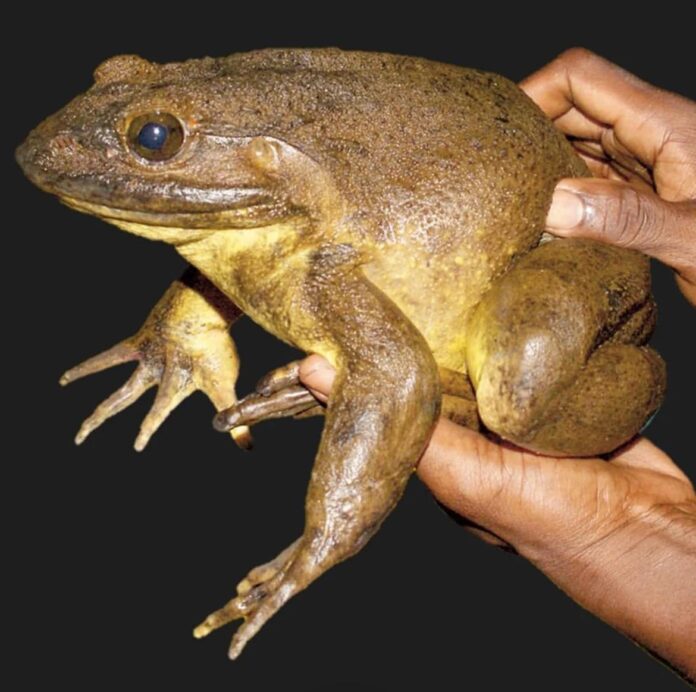Have you ever wondered how big the largest frogs can get? I have been having this question in my mind for a while so I decided to do some research on it. Just like you expect, we are going to talk about the 9 largest frogs today. Not everyone is a fan of these amphibians but it is nice to know something about them, right? Let’s take a look at the list of some of the biggest frog species below and don’t forget to share your thoughts.
9Smoky Jungle Frog
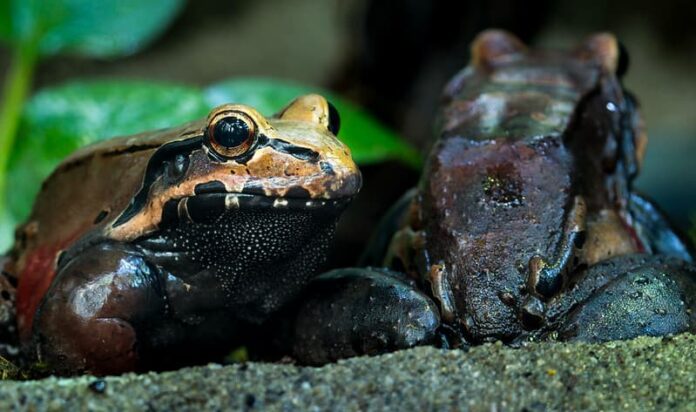
Length: 18 centimeters (7.1 inches)
A smoky jungle frog has brownish backs with black markings and creamy underparts. You can distinguish between a male and a female by the black spines on the male’s chest and thumbs. These spines aid the males with more and stronger grasp on the females during mating. These amphibians spend their daytime in burrows, leaf litter, or under logs in their habitats. At night, they come out to eat different food from the menu such as birds, chicks, and other invertebrates.
On top of that, smoky jungle frogs are the only frog known to eat scorpions; how impressive right? Even the tadpoles are carnivorous and fierce as they feed on eggs and even other tadpoles of their own species. However, they can also survive on a vegetarian diet in case the food is scarce. These frogs are also able to survive up to 156 hours without water which is almost a week.
The ranges of these incredible frogs are abundant in rainforests from Honduras to Panama and along the border of Colombia. Their natural habitats are aquaculture ponds, freshwater marshes, intermittent freshwater marshes, and tropical moist broadleaf forests. They prefer to live in areas like marshes, riverbanks, subtropical forests, swamps, and tropical lowland forests in northern South America. When threatened, smoky jungle frogs will try to appear larger by inflating their lungs and standing on all 4 legs. Then they release a slippery mucus-like secretion from their skin which is harmful to many animals. If the intruder does not go away, these frogs will emit a loud high-pitched shriek which is very loud. In the wild, this frog species can live up to 15 years of age while it can live a few years longer in captivity.
8Surinam Horned Frog

Length: 20 centimeters (8 inches)
With this size, a Surinam horned frog can sit comfortably in a good-size tea saucer which is quite large. Surinam horned frogs are found in freshwater marshes and pools throughout the Amazon Basin from Colombia to Brazil. As one of the largest frogs in the marshes, this species is not picky when it comes to what they eat. Since they are also ambush predators, they often hide under leaf litter or forest substrate to wait for prey. The moment a smaller meal comes by, they will spring from the hiding place and swallow the poor thing whole. Plus with the sharp teeth, the frogs can lock the prey in securely to ensure zero chances of escaping. The combination of the appetite, exceptionally wide mouths, sharp teeth, and strong jaws earned these frogs another nickname “Pac-Man frogs”.
A frog of this species has a stocky roundish body with bumpy skin and stubby limbs. It also has horn-like projections above the eyes that resemble the petioles of leaves. These projections do not only give the frogs their names but also the extra blending to aid in their camouflage. Being large and strong, the Surinam horned frogs are also very aggressive and territorial. All of them are solitary, and males aggressively defend their territories at all costs. However, they are still prey to large animals like birds and snakes that live in the ranges. Because they are unique, people collect them from the wild for pet trade purposes. Apart from this, habitat destruction is also one of the main reasons that threaten their population these days. The good thing is that their wild population is still large and stable.
7American Bullfrog
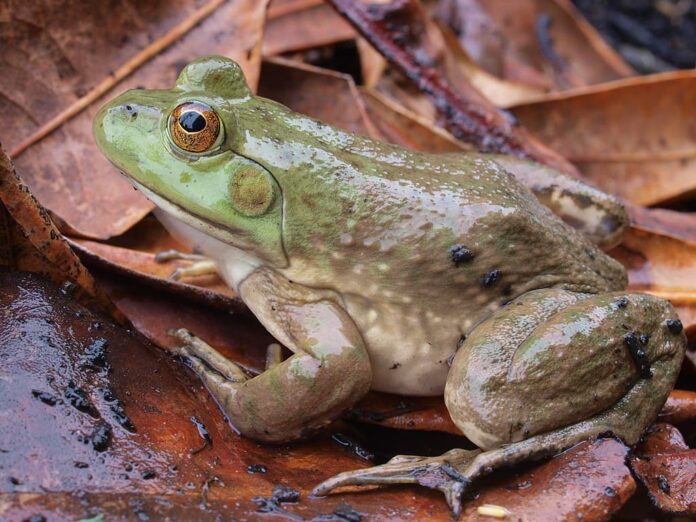
Length: 15 – 20 centimeters (6 – 8 inches)
The appearance of the American bullfrog resembles all the frogs we see in cartoons as kids. An American bullfrog has a green or greenish-brown body that can be in a dark or light shade. It has a broad and flat head, and of course, a large mouth. This frog species is a powerful swimmer thanks to its long strong back legs with large webbed feet. Those long legs also allow them to leap up to 1 meter (3 feet) in height or 2 meters (3 feet) in distance. The American bullfrogs live across much of the United States, and they range as far north as Canada. However, their number keeps expanding so they are also found in Asia, Europe, and South America as well.
As ambush predators and one of the largest frogs, these amphibians eat anything they can fit in their mouths. American bullfrogs are carnivorous, and they like to eat crayfish, dragonfly larvae, snails, and water beetles. Other diet includes birds, fish, insects, mice, small turtles, young water birds, and even other frogs. The American bullfrogs are generally solitary, but they will come together during the breeding season between May and July. At the same time, the males are highly territorial and they will aggressively guard their land from all intruders. They do so by using calls, chases, displays, jump attacks, and even wrestling to keep the invaders away. A female can lay as many as 25,000 which explains why their population can get out of control.
6Mountain Chicken Frog

Length: 20 centimeters
Famous for the taste of their appetizing legs, mountain chicken or mountain chicken frogs are one of a kind. Mountain chicken frogs are one of the largest frogs in the world whose popularity is as a traditional Caribbean dish. This species used to be found on many of the eastern Caribbean islands in a variety of moist habitats. However, they occur only on two islands now which are Dominica and Montserrat where their population is still low. On those 2 islands, these frogs live in dense vegetation, flood forests, and ravines with low elevations. During the daytime, they are inactive and hidden while becoming even more dormant during the dry season.
Just like other large frog species, this one is also an ambush predator with an amazing ability to hide. They often stay in burrows or rock crevices, but they are also good at camouflaging when not hiding. Thanks to their striking patterns, these frogs are able to blend into the forest floors while waiting to ambush prey. These fearless predators can remain still for long times before it catches its meal and swallows it whole. Their common meal includes crickets, crustaceans, insects, and small vertebrates like frogs, small mammals, and snakes. Unfortunately, mountain chicken frogs are classified as Critically Endangered due to habitat loss, overhunting by people, and volcanic activity. Another dangerous threat is the arrival of chytrid fungus in 2002 which wiped out their population on various islands.
5African Bull Frog
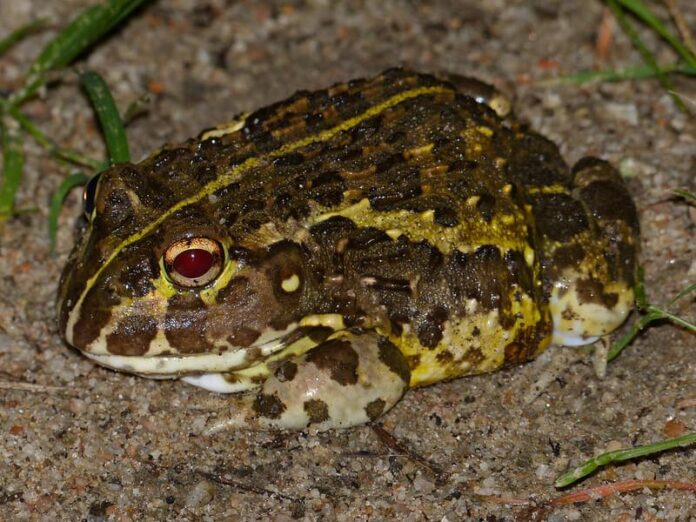
Length: 11.4 – 25.4 centimeters (4.5 – 10 inches)
The African bullfrogs are the largest frogs in Southern Africa whose size can reach a dinner plate. This frog species range from Southern Africa to Tanzania in the open country primarily at low elevations. An American bullfrog has short and blunt fingers without webbing, and it has a very large mouth. Inside the mouth are 3 large tooth-like projections in the front of its lower jaw that can grab the food. This also makes it one of the rare frog species that have teeth.
These large frogs are carnivores, and they feed on birds and other frogs. It can sit quietly for hours while partially burying in the earth with only its nose exposed as it waits for prey. Because it lives in Africa, it hibernates underground during the dry season which can take up to 10 months. Once the rain returns, it emerges from its hibernation and starts breeding right away.
The interesting thing about this species is that it is more aggressive than most others. An African bullfrog may inflate its body and attack an intruder with its huge mouth agape. Along with that, it also makes sounds when it is annoyed such as bleating, croaking, and roaring. Another thing is that they need to shed their skin from time to time, and eat it after. Not different from the mountain chicken, local people also consider their meat to be a delicacy as well. This is why humans are their main predators while these amphibians are already facing a big threat like habitat destruction. Surprisingly, people also collect them for the pet trade because this species is also popular as a pet. As for their natural predators, they are birds of prey, monitor lizards, and turtles that feed on juveniles.
4Blyth’s River Frog

Length: 9 – 26 centimeters (3.5 – 10.2 inches)
Native to Southeast Asia, Blyth’s river frog is one of the largest frogs in the world and where it comes from. This large frog species has smooth skin on the dorsum, either with or without scattered tubercles or longitudinal skin folds. Things are the same with the vertebral stripe on their backs since some have them and some don’t. Their coloration can be brownish, gray, or yellowish on the above parts with white or yellowish on the below parts. You can find them in Southeast Asian countries including Indonesia, Laos, Malaysia, Myanmar, Thailand, and Vietnam. Where they live, they prefer habitats such as primary and secondary evergreen forests as well as streams with gravel and rocks. Their major threats at the moment are collection for food and for trade along with habitat loss.
3Lake Junin Frog
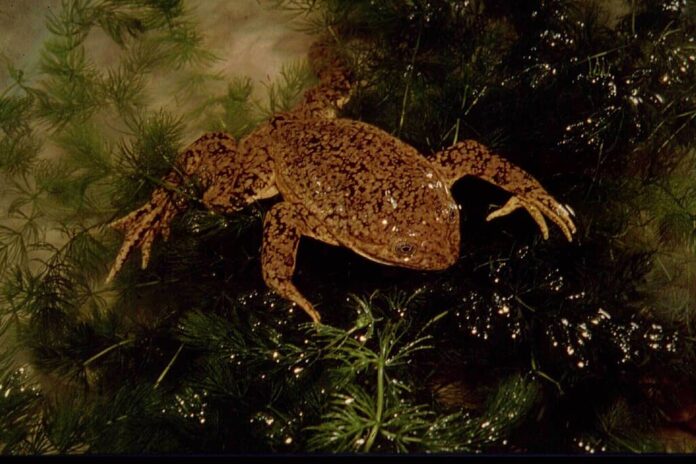
Length: 30 centimeters (12 inches)
Also known as the Andes smooth frog, the Lake Junin frog is one of the largest frogs that are also completely aquatic. This species is endemic to lakes and similar waters at altitudes of 4,000 to 4,600 meters (13,100 – 15,000 feet) deep. You can find them in the Andes of Junin and Pasco in Central Peru where their population is still existing. A Lake Junin frog has smooth skin with a dark brownish color, and they are very large in size. Apart from being among the largest frogs, these amphibians are also the largest exclusively aquatic frogs as well. Due to their size, Lake Junin frogs feed on larger beings like aquatic insects, aquatic snails, and even small fish. Not different from some big frogs on the list, this species is also rare and endangered. Their threats are agriculture and human waste, capture for human consumption, pollution, and predation by introduced trout.
2Chilean Giant Frog
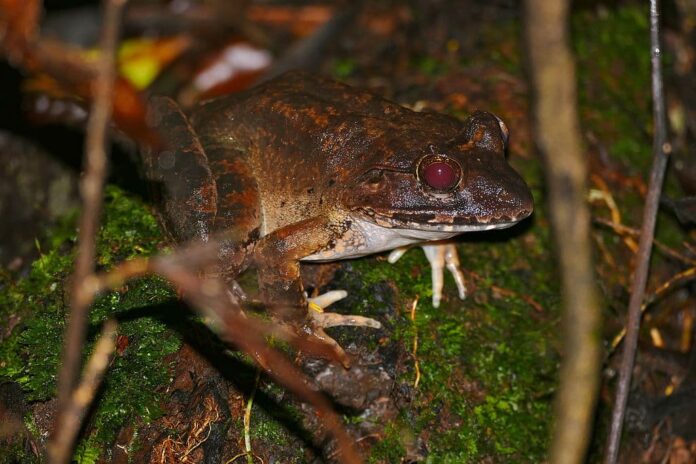
Length: 15.5 – 32 centimeters (6 – 13 inches)
Although they are frogs, Chilean giant frogs are more commonly known as helmeted water toads or wide-mouth toads instead. That is because of the broad head and large mouth that each individual in this species possesses. Mature Chilean giant frogs are robust, and their coloration ranges from brown and green to light green and yellow. As they get older, their color turns gray or they have gray patches on a dark background. This frog species is aquatic and semi-aquatic, living in deep ponds and reservoirs in central Chile. As you can see, these frogs are the second largest frogs and one of the largest frogs in the world. They feed on pretty much any animals they can swallow including fish, invertebrates, other frogs, small birds, and small mammals. Sadly, their population is considered Vulnerable due to capture for human consumption, disease, habitat loss, introduced species, and pollution.
1Goliath Frog
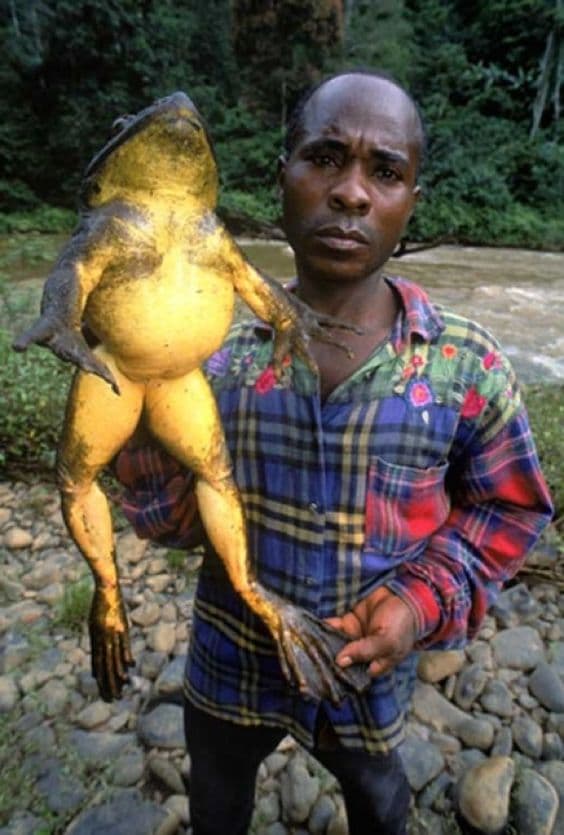
Length: 17 – 32 centimeters (7 – 13 inches)
Any animal species with the name Goliath as their first name always indicate them as the largest, and so is this one. Goliath frogs are the largest frogs in the world, with a bizarre size that not everyone would handle. A Goliath frog is green in color with a granular texture and yellow-orange on the underside of the body. Because they are large and heavy, you probably think these frogs are slow. Little did you know that this giant frog here can leap up to an impressive height of 3 meters (10 feet). On top of that, they have large eyes for amazing sight along with an acute sense of hearing. This simply means they are able to locate and hunt prey without a single problem. As carnivores, Goliath frogs feed on anything they can catch from small to big like bats, fish, small snakes, etc.
Sometimes they eat snakes, sometimes larger snakes eat them. Their predators are also other animals like large lizards and Nile crocodiles. They can be found only in restricted areas in Cameroon and Equatorial Guinea with favorable conditions for them. Their habitats are fast-flowing rivers and streams with sandy bottoms that are typical for humid and dense rainforests. Living near rivers and waterfalls, Goliath frogs are also excellent and fast swimmers which is beneficial for hunting and survival. During the mating season from July to August, males would wrestle to establish dominance and gain opportunities to mate. Similar to many large frogs on the list, the population of this species is also declining. The threats to their number are habitat loss due to deforestation, hunting for food, and over-collecting for pet trade.
Related Post: Venomous Frogs That Can Kill You

